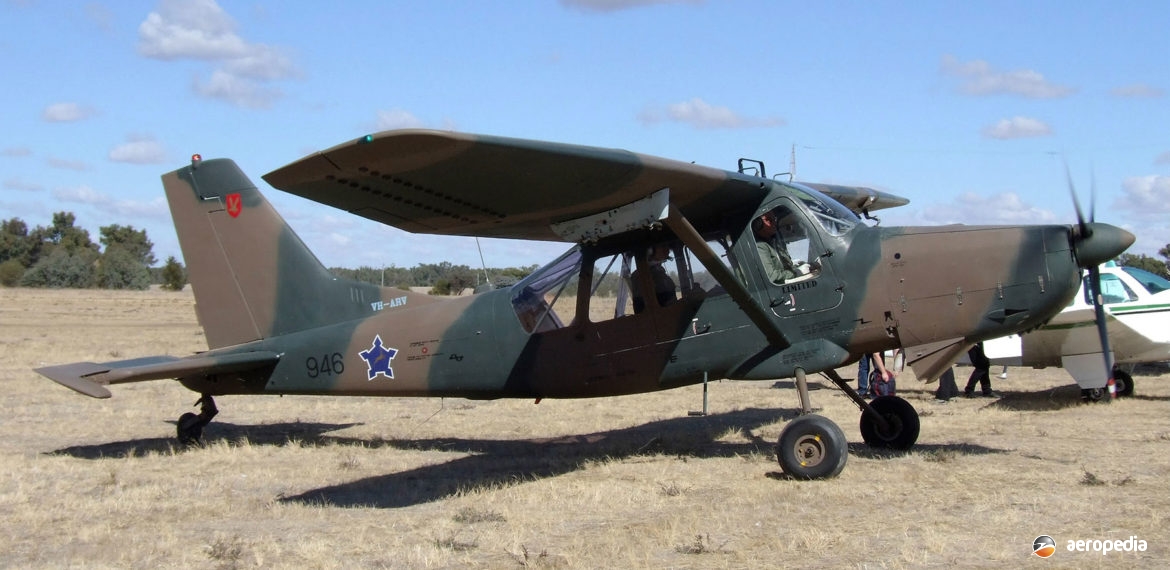Photograph:
Macchi AM-3 Bosbok VH-ARV (c/n 2027) at Narrandera, NSW in August 2006 (David C Eyre)
Country of origin:
Italy
Description:
Military forward air-control and light COIN aircraft
Power Plant:
One 254 kw (340 hp) Piaggio-built Lycoming GSO-480-B1B6 six-cylinder horizontally opposed air-cooled engine
Specifications:
- Wingspan: 12.64 m (41 ft)
- Length: 8.73 m (28 ft 7¾ in)
- Height: 2.72 m (8 ft 11 in)
- Wing area: 20.26 m² (219.2 sq ft
- Max speed at 2,440 m (8,005 ft): 278 km/h (173 mph)
- Max cruising speed at 75% power at 2,440 m (8,005 ft): 246 km/h (153 mph)
- Service ceiling: 8,400 km (27,560 ft)
- Take-off run: 85 m (279 ft)
- Landing run: 66 m (217 ft)
- Max range at cruising speed with 30 mins reserves: 990 km (615 miles)
- Empty weight: 1,080 kg (2,381 lb)
- Max loaded weight: 1,700 kg (3,748 lb)
)
History:
The AM-3 was a joint venture by Aerfer Industrie Aerpospaciali Meridionali SpA of Turin, and Aermacchi of Varese, to produce a three-seat light tactical support and observation aircraft. Developed from Lockheed’s (Georgia Division) CL-402 general purpose utility aircraft, which became the LASA-60, the prototype first flew on 12 May 1967 and, compared with the L-402, there were a number of changes involved, one of which was the installation of the Piaggio licence-built Lycoming GSO-480-B1B6 engine in place of the Continental unit. The second prototype was built by Aerfer and first flew on 22 August 1968. The aircraft is a high-wing braced monoplane with an all-metal D-spar torsional-box structure with piano-type ailerons and Fowler-type flaps. Construction is of welded chrome-molybdenum steel tube, covered towards the front with light alloy skinning, and the rear of light alloy. The cantilever all-metal tail has a variable camber tailplane and the rudder has a spring tab. The third seat could be removed to accommodate a stretcher or freight, and access is via three doors.
Offered to the Italian Air Force, it was rejected in favour of the turbine powered SIAI-Marchetti SM.1019. It was then offered to the United States military as an AOP/light COIN aircraft for use in Vietnam, being evaluated by that service, but lost out to the Helio Courier. The type was eventually ordered by the South Africa Air Force, with an order for 40, and three for Rwanda. Deliveries commenced in 1973. Nos 41 and 42 Squadrons SAAF operated the type and it was used extensively in sorties against terrorists operating in South West Africa. Later Atlas Aircraft in South Africa developed the type as a light utility transport, and this became known as the C-4M Kudu. After retirement from South African service the type has become popular with operators of ex-military aircraft, two examples being imported to Australia and becoming VH-BTZ (c/n 2032) and VH-ARV (c/n 2027).

